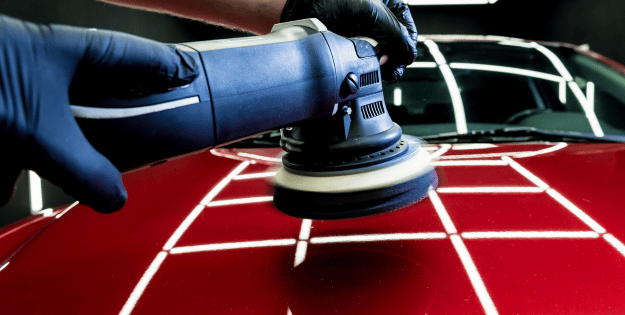Maintaining a car’s pristine appearance is a task that many vehicle owners hold dear. With exposure to road salt, airborne pollutants, and harsh weather conditions, a car’s exterior can quickly lose its lustre. Enter the dynamic duo of car wax and polish—essential tools in the quest for automotive perfection. While often confused, these two products serve distinct purposes in preserving a car’s beauty.
When it comes to choosing the best car polish, it’s important to compare various products available in the market. High-quality polishes are essential for maintaining the vehicle’s appearance and providing protection against environmental factors. The best car polish can effectively enhance car paintwork by eliminating minor scratches and imperfections, preparing the surface for the wax’s final touch. Together, they create a smooth, reflective finish that not only looks stunning but also extends the life of the car’s clearcoat. For those seeking the best results, understanding the roles of wax and polish is key.
- Distinct Roles: Car wax and polish serve different purposes; wax acts as a protective layer enhancing shine, while polish smooths imperfections and prepares the surface for waxing.
- Application Techniques: Proper application techniques, including washing, drying, and using appropriate tools, ensure optimal results with both wax and polish, enhancing the car’s appearance and longevity.
- Types and Selection: Understanding different types, such as paste and liquid waxes, helps in choosing products that suit individual needs for protection, durability, and ease of use.
- Benefits and Limitations: While car wax offers protection and enhances shine, it requires careful application and doesn’t substitute more robust paint protection solutions.
Top Car Wax
Understanding Car Wax And Polish
Car wax and polish are two essential products used to maintain a vehicle’s exterior. Car wax, often made from carnauba wax or beeswax, creates a protective barrier on the surface, enhancing shine and guarding against contaminants like UV rays, rain, and tree sap. In contrast, car polish addresses imperfections such as scratches and swirl marks by smoothing them out, leaving a clean surface ready for waxing. Though they’re often used together, polish preps the surface for the best car wax and ensures the exterior maintains a high gloss, reflective finish. Recognising their distinct roles helps car enthusiasts achieve optimal results in preserving and enhancing the car’s paintwork.
Key Features To Consider
When selecting the best car wax and polish, consider durability, ease of application, and protection. Durability determines how long the product maintains the car’s shine and guard against external factors. It also plays a crucial role in protecting the car’s finish from environmental elements like UV rays and grime. Ease of application relates to the user-friendliness of the product, ensuring that anyone can apply it without hassle. Protection refers to the level of defence the wax or polish offers against UV rays, water spots, and contaminants. Evaluating these features guarantees that the chosen products deliver a lasting, glossy finish, enhancing the car’s aesthetic while safeguarding its surface.
Top Rated Wax And Polish Types
Choosing the best car wax and polish involves understanding the different types available. The best car waxes offer enhanced gloss, long-lasting protection, and water repellency, improving the car’s appearance while providing essential protection against UV rays and environmental elements. Each type offers unique benefits tailored to specific needs and preferences.
Paste Waxes
Paste waxes, known for their longevity, provide superior protection for car surfaces. They come in tubs and are applied using a microfiber or foam applicator pad. Though application requires effort, they ensure a tough, glossy finish, preserving the vehicle’s paintwork against UV rays and contaminants.
Liquid Waxes
Liquid waxes offer convenient application, often with quick-drying properties. Compared to other waxes, liquid waxes excel in ease of use but may fall short in longevity and durability. They’re ideal for users seeking ease of use, as they can be applied with microfiber cloths or even foam cannons for touchless waxing. While they might not last as long as pastes, they deliver an impressive shine and adequate protection against environmental factors.
Carnauba Wax: A natural and eco-friendly alternative
Carnauba wax is a natural and eco-friendly alternative to synthetic waxes, derived from the leaves of the carnauba palm tree. This wax is a favorite among car enthusiasts who prioritise environmental sustainability. Being biodegradable and non-toxic, carnauba wax is a safer choice for both the environment and human health. Additionally, it is a renewable resource, as the carnauba palm tree can be harvested without causing harm.
Carnauba wax is renowned for its excellent protective properties, forming a durable barrier against the elements and helping to maintain the car’s paintwork. Its application and removal are straightforward, making it a convenient option for car owners who want to keep their vehicle looking pristine. Popular brands like Chemical Guys, Auto Finesse, and Meguiar’s offer carnauba-based products in various forms, including paste wax, liquid wax, and wet wax, catering to different preferences and needs.
Best Car Wax and Polish Products
When it comes to choosing the best car wax and polish products, several top-rated options stand out in the market:
- Chemical Guys Butter Wet Wax: This product is a favorite among car enthusiasts for its ease of application and removal. It provides a decent shine and is perfect for those looking for a quick and effective waxing solution.
- Auto Finesse Illusion: Known for its high-end quality, Auto Finesse Illusion offers an ultimate shine and a protective layer that lasts for months. It’s ideal for car owners who want their vehicle to look showroom-ready.
- Meguiar’s Ultimate Paste Wax: This durable and long-lasting wax is popular for its high-gloss finish. It provides a robust protective layer, ensuring the car’s paintwork remains in top condition.
- Meguiar’s Ultimate Liquid Wax: Offering convenience and ease of application, this liquid wax delivers a high-gloss finish and a protective layer, making it a go-to choice for many car owners.
Application Techniques For Optimal Results
Achieving a flawless finish with the best car wax and polish involves precise application methods. First, start with a freshly washed and dried car to remove surface dirt and water spots. Apply polish using a foam applicator pad or microfibre cloth in a circular motion, meticulously addressing scratches and swirl marks. Buff the surface to reveal a smooth, glossy finish, ensuring it’s prepared for waxing.
When applying wax, use a clean applicator pad, spreading evenly across small sections of the car. Allow it to haze, typically for 5-10 minutes, before buffing with a microfibre towel. This technique ensures comprehensive coverage, delivering optimal shine and protection. Use consistent pressure and overlapping strokes to avoid missed areas, enhancing the car’s appearance and longevity.
Eco-Friendly Car Waxes
Eco-friendly car waxes are gaining popularity among car enthusiasts who are conscious of their environmental impact. Here are some top-rated eco-friendly car waxes:
- Chemical Guys Eco-Friendly Car Wax: Made from natural ingredients, this biodegradable and non-toxic wax is a great choice for those looking to reduce their environmental footprint.
- Auto Finesse Eco-Wax: This plant-based wax is free from harsh chemicals and toxins, providing a safe and effective way to maintain your car’s appearance.
- Meguiar’s Eco-Friendly Car Wax: A water-based wax that is both biodegradable and non-toxic, offering an environmentally friendly option without compromising on performance.
Climate-Specific Car Waxes
Different climates require different types of car waxes to ensure optimal protection and performance. Here are some top-rated climate-specific car waxes:
- Chemical Guys Hot Weather Car Wax: Specifically designed for hot and sunny climates, this wax provides excellent protection against UV rays and heat, ensuring your car’s paintwork remains intact.
- Auto Finesse Cold Weather Car Wax: Ideal for cold and snowy climates, this wax offers robust protection against harsh weather conditions, preventing damage from snow and ice.
- Meguiar’s All-Weather Car Wax: This versatile wax is designed to provide protection in all types of weather conditions, making it a reliable choice for car owners in varying climates.
Top Brands for Car Wax and Polish
Several brands stand out in the car wax and polish market for their quality and performance:
- Chemical Guys: A popular brand among car enthusiasts, Chemical Guys is known for its high-quality and eco-friendly car wax and polish products. Their range includes options for different needs and preferences, ensuring a perfect fit for every car owner.
- Auto Finesse: This high-end brand offers a range of car wax and polish products that provide an ultimate shine and a protective layer. Auto Finesse is a go-to choice for those seeking premium quality.
- Meguiar’s: A well-established brand, Meguiar’s offers a variety of car wax and polish products that deliver a high-gloss finish and a protective layer. Their products are known for their durability and ease of use.
- Other Popular Brands: Brands like 3M, Turtle Wax, and Simoniz also offer reliable car wax and polish products, providing car owners with a wide range of options to choose from.
By understanding the distinct roles of car wax and polish, and selecting the best products for your specific needs, you can achieve a high-gloss finish that enhances your car’s appearance and longevity.
Pros And Cons Of Using Car Wax
Car wax offers several benefits for vehicle maintenance. It provides a protective layer that shields paint from UV rays and pollutants. This protection helps maintain the car’s appearance and facilitates easier cleaning by repelling contaminants. Wax also enhances the vehicle’s shine, giving it a polished, attractive look. However, not everyone finds car wax application straightforward. It can be time-consuming, requiring careful application and frequent reapplication depending on the product’s durability. Moreover, while car wax can fill minor imperfections, it doesn’t replace more robust forms of paint protection. Some waxes are also specific to certain colours, so users must choose wisely to achieve enhanced aesthetic results.
Different waxes, such as hard and liquid waxes, offer distinct feels and performance attributes. For instance, a white wax can significantly affect the depth of shine and color warmth on various paint finishes.
Selecting the best car wax and polish is essential for maintaining a vehicle’s aesthetic and protecting its surface. By understanding the distinct roles of wax and polish, car enthusiasts can achieve a high-gloss finish that enhances their car’s appearance and longevity. Evaluating factors like durability, ease of application, and protection ensures the chosen products meet individual needs.
With various types of waxes and polishes available, users can tailor their choices to specific preferences, whether prioritising longevity or convenience. Proper application techniques further enhance results, providing comprehensive coverage and a lasting shine. By considering performance evaluations, consumers can confidently choose products that deliver exceptional quality and satisfaction.
What is the difference between car wax and car polish?
Car wax and car polish serve different purposes in car maintenance. Car wax provides a protective layer, enhancing shine and guarding against contaminants like UV rays and rain. Car polish, however, removes minor scratches and swirl marks, smoothing the surface in preparation for waxing. Together, they ensure a smooth, glossy finish that maintains the car’s appearance and prolongs the life of the clearcoat.
How often should you wax your car?
It is recommended to wax your car every three to four months. This frequency maintains the protective layer against environmental factors, ensuring continuous shine and easier cleaning. However, factors such as exposure to harsh climates or frequent washing may necessitate more frequent application.
What features should I consider when choosing car wax and polish?
Key features to consider include durability, ease of application, and protection. Durability ensures long-lasting shine and resistance to contaminants. Ease of application relates to user-friendliness, allowing for a smoother experience. Protection evaluates how well the product defends against UV rays, water spots, and pollutants, ensuring the car’s surface remains safeguarded.
How do you properly apply car wax?
Start with a freshly washed and dried car to remove any contaminants. Use a clean applicator pad to apply a small amount of wax to a small section of the car in a circular motion. Allow the wax to haze, then buff it with a microfibre towel. This technique ensures comprehensive coverage and enhances the car’s longevity.
What are the pros and cons of using car wax?
Car wax offers numerous benefits, including protection against UV rays and pollutants, enhanced shine, and easier cleaning by repelling contaminants. However, it can be time-consuming to apply and may require frequent reapplication depending on its durability. Wax can fill minor imperfections but does not replace more robust paint protection options.












